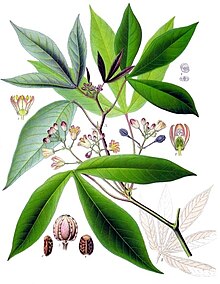**1. Cassava Description and Importance:**
– Cassava is a woody shrub native to South America, cultivated for its edible starchy root tuber.
– It is a major source of carbohydrates and ranks as the third-largest source of food carbohydrates in the tropics.
– Nigeria is the largest producer of cassava.
– Optimal growth conditions include mean annual temperatures between 20 and 29°C and annual precipitation between 1,000 and 2,500mm.
– Cassava is cultivated for starch extraction and bio-fuel production in countries like Thailand, Cambodia, and Vietnam.
– In parts of eastern Indonesia, it is a valued food staple.
– Portuguese and Spanish traders introduced cassava to colonies in Goa, Malacca, and the Philippines.
**2. Cassava Genome and Storage Tubers:**
– The African cassava genome has been reconstructed using Hi-C technology, revealing novel gene loci related to chromatin organization.
– Small cassava farmers play a crucial role in maintaining genetic diversity.
– MeFT1 gene affects storage root formation in cassava, influencing sucrose allocation.
– MeFT2 expression is photoperiodic, and overexpression of MeFT1 reduces storage root accumulation.
– HiFi genome assembly showed extensive chromosome rearrangements.
**3. Cassava Taxonomy and Toxicity:**
– Cassava belongs to the spurge family, Euphorbiaceae, and is classified as sweet or bitter.
– Bitter varieties contain higher levels of toxins, requiring proper preparation to avoid cyanide intoxication.
– Farmers prefer bitter varieties for pest deterrence.
**4. Cassava History and Global Exchange:**
– Domesticated cassava likely originated in west-central Brazil and dates back at least 10,000 years.
– It was a staple food for pre-Columbian peoples and introduced to Africa by Portuguese traders.
– Spaniards initially avoided cassava and maize.
– Maize and cassava have become important staple foods in regions like Tanzania.
– Cassava cultivation is documented in South India before 1880-1885CE.
– In Asian countries like Vietnam, fresh cassava is not a significant part of human diets.
**5. Cassava Legends and Misconceptions:**
– Cassava cultivation in Kerala existed before the 19th century, with a legend tied to a famine.
– The King of Travancore, Vishakham Thirunal Maharaja, is linked to the introduction of cassava in Kerala.
– The term tapioca is used for cassava in Indian English, and in Malayalam, it is called kappa or maricheeni.
– Fresh cassava is not a significant part of human diets in Asian countries like Vietnam.
– Cassava should not be confused with breadfruit or the African breadfruit, and it is distinct from the tropical and equatorial bread tree.
Manihot esculenta, commonly called cassava (/kəˈsɑːvə/), manioc, yuca, or tapioca (among numerous regional names) is a woody shrub of the spurge family, Euphorbiaceae, native to South America, from Brazil, Paraguay and parts of the Andes. Although a perennial plant, cassava is extensively cultivated as an annual crop in tropical and subtropical regions for its edible starchy root tuber, a major source of carbohydrates. Cassava is predominantly consumed in boiled form, but substantial quantities are used to extract cassava starch, called tapioca, which is used for food, animal feed, and industrial purposes. The Brazilian farinha, and the related garri of West Africa, is an edible coarse flour obtained by grating cassava roots, pressing moisture off the obtained grated pulp, and finally drying it (and roasting both in the case of farinha and garri).
| Cassava | |
|---|---|

| |

| |
| Tuber (waxed) | |
| Scientific classification | |
| Kingdom: | Plantae |
| Clade: | Tracheophytes |
| Clade: | Angiosperms |
| Clade: | Eudicots |
| Clade: | Rosids |
| Order: | Malpighiales |
| Family: | Euphorbiaceae |
| Genus: | Manihot |
| Species: | M. esculenta
|
| Binomial name | |
| Manihot esculenta | |
| Synonyms | |
| |
Cassava is the third-largest source of food carbohydrates in the tropics, after rice and maize. Cassava is a major staple food in the developing world, providing a basic diet for over half a billion people. It is one of the most drought-tolerant crops, capable of growing on marginal soils. Nigeria is the world's largest producer of cassava, while Thailand is the largest exporter of cassava starch.
Cassava is classified as either sweet or bitter. Like other roots and tubers, both bitter and sweet varieties of cassava contain antinutritional factors and toxins, with the bitter varieties containing much larger amounts. It must be properly prepared before consumption, as improper preparation of cassava can leave enough residual cyanide to cause acute cyanide intoxication, goiter, ataxia, partial paralysis, or death. The more toxic varieties of cassava have been used in some places as famine food during times of food insecurity. Farmers often prefer the bitter varieties because they deter pests, animals, and thieves.
